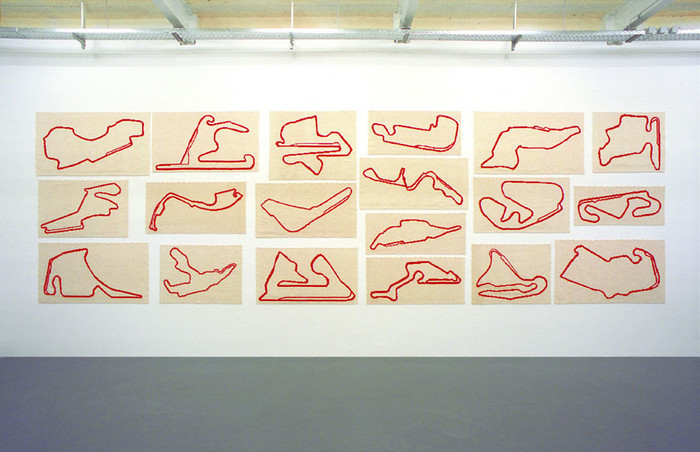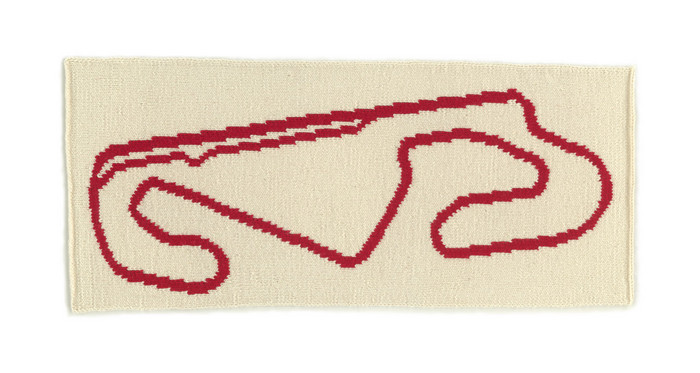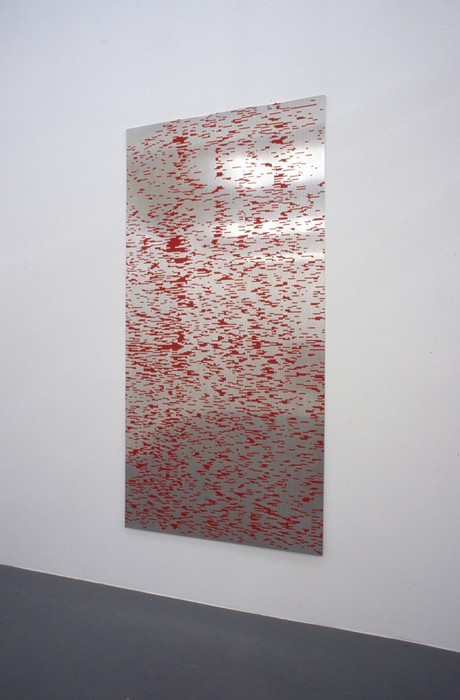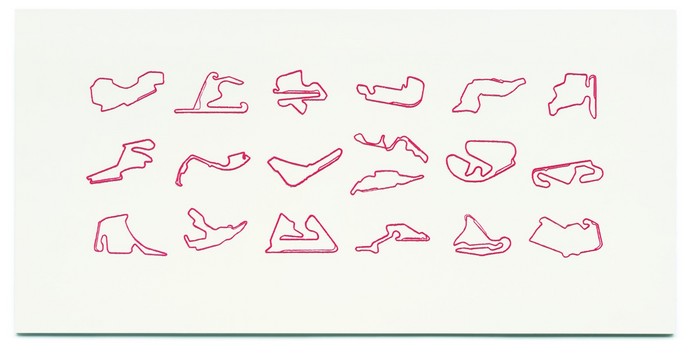Bea Meyer ROT / WEISS / HOCKEN / HEIM
09 Sep - 14 Oct 2006

Installation
2006, Galerie b2_
o.T.
2006, Installation
(19 Rennstrecken/ Racetracks)
unterschiedliche Größen/ various Sizes
handgestrickt/ hand knitted
Turkey Rug Wool col. 050, 850
JUNI
2006, 144 x 144 cm
Tamiya, col. PC-2
auf Aluminium 2 mm
2006, Galerie b2_
o.T.
2006, Installation
(19 Rennstrecken/ Racetracks)
unterschiedliche Größen/ various Sizes
handgestrickt/ hand knitted
Turkey Rug Wool col. 050, 850
JUNI
2006, 144 x 144 cm
Tamiya, col. PC-2
auf Aluminium 2 mm
Bea Meyer
ROT / WEISS / HOCKEN / HEIM
Bea Meyer thematisiert in ihrer Ausstellung ROT / WEISS / HOCKEN / HEIM zwei sehr unterschiedliche Bereiche des gesellschaftlichen Lebens, die eng mit Vorurteilen und klischeebesetzen Vorstellungen einhergehen: die Formel 1 und das Stillen.
Bea Meyer zeigt zum einen die Grundrisse aller 19 Rennstrecken der Formel 1, die es von Australien über Deutschland bis Brasilien gibt. Sie greift die abstrakten Formen der Strecken auf und zeigt im Nebeneinander deren unterschiedliche Verläufe, die von ihr in Strickbilder übersetzt werden . Die Strecken sind mit roter Wolle gestrickt und mit weiß-gelblichem Grund umfasst. Meyer zweckentfremdet das Stricken, fertigt keine Pullover oder Handschuhe, sondern Bilder, deren formale Qualität sie als eigenständige Kommentare und Erzeugnisse im Kunstkontext ausweist. Sie überträgt die Koordinaten eines ausschließlich Männern vorbehaltenen Sports in ein im weitesten Sinne Frauen zugeschriebenes Terrain. In der Menge der Bilder wird deutlich, wie beschränkt die Bewegungsfreiheiten im Rennen sind, wie eng und vorgegeben der Ablauf ist. Der Rundkurs wird zu einem Strickmuster.
Den anderen Bildern ihrer Ausstellung liegen Stillprotokolle zu Grunde. Für den Betrachter erschließt sich dieser spezielle Zusammenhang allerdings kaum. Zu sehen ist ein abstraktes Muster, das Meyer auf großformatige Metallplatten lackiert hat und das an konzeptuelle oder minimalistische Bildfindungsprozesse denken lässt, aber nicht an ein persönliches und intimes Protokoll über das Stillverhaltens eines Kindes. Meyer dokumentiert einen privaten und intimen Bereich, ohne dabei das Private exhibitionistisch werden zu lassen. Gleichzeitig demontiert sie den Mythos erzwungener Mutter-Kind-Harmonie, in dem sie ein kühles und distanziertes Verfahren der Darstellung wählt und Stillen als statistische Größe vorführt, das einer Reihe an intensiven Schwankungen unterworfen ist. Meyer schafft es in beiden Arbeiten, die Grundstrukturen und möglichen Widersprüche, Verhärtungen und Absurditäten der jeweiligen Abläufe offenzulegen. Während die Rennstrecken en miniature präsentiert werden und erst in dieser Maßstabsverkleinerung die oben beschriebene Analyse zulassen, werden in den Stillprotokollen Form und Inhalt vergrößert und soweit abstrahiert, dass eine grundsätzliche Diskussion auch hier möglich wird. Bea Meyer zeigt wie sehr alle Beteiligten, unabhängig vom sozialen und gesellschaftlichen Status, in der Endlosschleife ihrer Rollenzuschreibungen fest hängen.
Die Technik der künstlerischen Übertragung und Darstellung spielt eine zentrale Rolle in der Arbeit von Bea Meyer. Sie kontrastiert, überarbeitet und interpretiert die unterschiedlichen Materialien präzise und zugleich subtil. Die Künstlerin schafft es die vorgegebenen Bedeutungsebenen von bestimmten Materialien und Gebrauchsweisen in Frage zu stellen, ohne dabei stereotyp oder klischeehaft zu argumentieren. In der aktuellen Ausstellung ist die Übersetzung in konzeptuelle, geometrische Malerei oder in Strickbilder befreit von jedem expressiven Moment und befragt in erster Linie ein technisches Reproduktionsverfahren auf seine ästhetischen Qualitäten. Die rationalen und emotionalen Anteile werden von Meyer geschickt ausgetauscht und die klaren Frontlinien zwischen männlichen und weiblichen Positionen verschoben. Den persönlichen Lebenshintergrund und nicht zuletzt auch die spezifischen Bedingungen der gesellschaftlichen Rolle als Frau klar zu benennen und die formalen Herausforderungen des Materials souverän zu beherrschen, ermöglicht eine intensive Konfrontation mit den genannten Inhalten im Spannungsfeld zwischen künstlerischer Arbeit und gesellschaftlichem Kommentar.
Text: Maik Schlüter
Bea Meyer thematizes in her exhibition RED/WHITE/HOCKEN/HEIM two quite divergent areas of social life which are closely interwoven with prejudices and clichéd concepts: Formula One Motor Racing and breastfeeding. On the one hand, Meyer presents the ground plans of all nineteen Formula One racetracks, from Australia through Germany all the way to Brazil. She takes up the abstract forms of the racetracks and through this juxtaposition depicts their diverse progressions, which she translates into knitted images. The routes are knitted with red wool and surrounded by a white-yellowish background. Meyer uses knitting for another purpose, producing not sweaters or mittens but instead pictures whose formal quality reveals them to be independent commentaries and creations within an artistic context. She transfers the coordinates of a sport reserved exclusively for men onto a terrain designated in the widest sense as belonging to women. In the large number of pictures, it becomes clear how limited is the freedom to maneuver during the race, how narrow and prescribed is the competitive sequence. The circuit becomes a knitted pattern.
The other pictures of her exhibition are based on breastfeeding transcripts. For the viewer, however, this special context scarcely becomes apparent. What may be seen instead is an abstract pattern which suggests conceptual or minimalist processes of pictorial invention, but not an intimate personal transcript of the breastfeeding behavior of a child. Even though Meyer documents a private and intimate domain, nonetheless she never allows the personal aspect to become exhibitionistic. At the same time, she demolishes the myth of a forced harmony between mother and child, inasmuch as she selects a cool and distanced representational procedure and presents breastfeeding in terms of statistics which are subject to a series of intense oscillations. In both series of works, Meyer accomplishes a revelation of the fundamental structures and possible contradictions, ossifications and absurdities inherent to the respective procedures. Whereas the racetracks are presented en miniature and only in this reduction of scale permit the aforementioned analysis, form and contents are enlarged and abstracted in the breastfeeding transcripts to the point where a fundamental discussion becomes possible here as well. Bea Meyer demonstrates the degree to which all protagonists, independently of their social and communal status, are caught in the endless loop of their assigned roles.
The technique of artistic transfer and representation plays a central role in the work of Bea Meyer. She contrasts, reworks and interprets the various materials both precisely and subtly. The artists succeeds in putting into question the preexisting significatory levels of certain materials and types of utilization without ever arguing in a stereotypical or clichéd manner. In the current exhibition, the transposition into a conceptual, geometrical style of painting or in knitted images, is free from all expressive aspects and, above all, investigates a procedure of technical reproduction in terms of its aesthetic qualities. Meyer cleverly interchanges the rational and emotional elements and shifts the clearly delineated front lines laid out between masculine and feminine positions. By means of her clear formulation both of this autobiographical background and, not least of all, of the specific conditions surrounding the social role assigned to women, along with her consummate mastery of the formal challenges offered by the material, Bea Meyer is able to achieve an intense confrontation with her thematic contents in a dynamic field emanating between the poles of artistic work and social commentary.
ROT / WEISS / HOCKEN / HEIM
Bea Meyer thematisiert in ihrer Ausstellung ROT / WEISS / HOCKEN / HEIM zwei sehr unterschiedliche Bereiche des gesellschaftlichen Lebens, die eng mit Vorurteilen und klischeebesetzen Vorstellungen einhergehen: die Formel 1 und das Stillen.
Bea Meyer zeigt zum einen die Grundrisse aller 19 Rennstrecken der Formel 1, die es von Australien über Deutschland bis Brasilien gibt. Sie greift die abstrakten Formen der Strecken auf und zeigt im Nebeneinander deren unterschiedliche Verläufe, die von ihr in Strickbilder übersetzt werden . Die Strecken sind mit roter Wolle gestrickt und mit weiß-gelblichem Grund umfasst. Meyer zweckentfremdet das Stricken, fertigt keine Pullover oder Handschuhe, sondern Bilder, deren formale Qualität sie als eigenständige Kommentare und Erzeugnisse im Kunstkontext ausweist. Sie überträgt die Koordinaten eines ausschließlich Männern vorbehaltenen Sports in ein im weitesten Sinne Frauen zugeschriebenes Terrain. In der Menge der Bilder wird deutlich, wie beschränkt die Bewegungsfreiheiten im Rennen sind, wie eng und vorgegeben der Ablauf ist. Der Rundkurs wird zu einem Strickmuster.
Den anderen Bildern ihrer Ausstellung liegen Stillprotokolle zu Grunde. Für den Betrachter erschließt sich dieser spezielle Zusammenhang allerdings kaum. Zu sehen ist ein abstraktes Muster, das Meyer auf großformatige Metallplatten lackiert hat und das an konzeptuelle oder minimalistische Bildfindungsprozesse denken lässt, aber nicht an ein persönliches und intimes Protokoll über das Stillverhaltens eines Kindes. Meyer dokumentiert einen privaten und intimen Bereich, ohne dabei das Private exhibitionistisch werden zu lassen. Gleichzeitig demontiert sie den Mythos erzwungener Mutter-Kind-Harmonie, in dem sie ein kühles und distanziertes Verfahren der Darstellung wählt und Stillen als statistische Größe vorführt, das einer Reihe an intensiven Schwankungen unterworfen ist. Meyer schafft es in beiden Arbeiten, die Grundstrukturen und möglichen Widersprüche, Verhärtungen und Absurditäten der jeweiligen Abläufe offenzulegen. Während die Rennstrecken en miniature präsentiert werden und erst in dieser Maßstabsverkleinerung die oben beschriebene Analyse zulassen, werden in den Stillprotokollen Form und Inhalt vergrößert und soweit abstrahiert, dass eine grundsätzliche Diskussion auch hier möglich wird. Bea Meyer zeigt wie sehr alle Beteiligten, unabhängig vom sozialen und gesellschaftlichen Status, in der Endlosschleife ihrer Rollenzuschreibungen fest hängen.
Die Technik der künstlerischen Übertragung und Darstellung spielt eine zentrale Rolle in der Arbeit von Bea Meyer. Sie kontrastiert, überarbeitet und interpretiert die unterschiedlichen Materialien präzise und zugleich subtil. Die Künstlerin schafft es die vorgegebenen Bedeutungsebenen von bestimmten Materialien und Gebrauchsweisen in Frage zu stellen, ohne dabei stereotyp oder klischeehaft zu argumentieren. In der aktuellen Ausstellung ist die Übersetzung in konzeptuelle, geometrische Malerei oder in Strickbilder befreit von jedem expressiven Moment und befragt in erster Linie ein technisches Reproduktionsverfahren auf seine ästhetischen Qualitäten. Die rationalen und emotionalen Anteile werden von Meyer geschickt ausgetauscht und die klaren Frontlinien zwischen männlichen und weiblichen Positionen verschoben. Den persönlichen Lebenshintergrund und nicht zuletzt auch die spezifischen Bedingungen der gesellschaftlichen Rolle als Frau klar zu benennen und die formalen Herausforderungen des Materials souverän zu beherrschen, ermöglicht eine intensive Konfrontation mit den genannten Inhalten im Spannungsfeld zwischen künstlerischer Arbeit und gesellschaftlichem Kommentar.
Text: Maik Schlüter
Bea Meyer thematizes in her exhibition RED/WHITE/HOCKEN/HEIM two quite divergent areas of social life which are closely interwoven with prejudices and clichéd concepts: Formula One Motor Racing and breastfeeding. On the one hand, Meyer presents the ground plans of all nineteen Formula One racetracks, from Australia through Germany all the way to Brazil. She takes up the abstract forms of the racetracks and through this juxtaposition depicts their diverse progressions, which she translates into knitted images. The routes are knitted with red wool and surrounded by a white-yellowish background. Meyer uses knitting for another purpose, producing not sweaters or mittens but instead pictures whose formal quality reveals them to be independent commentaries and creations within an artistic context. She transfers the coordinates of a sport reserved exclusively for men onto a terrain designated in the widest sense as belonging to women. In the large number of pictures, it becomes clear how limited is the freedom to maneuver during the race, how narrow and prescribed is the competitive sequence. The circuit becomes a knitted pattern.
The other pictures of her exhibition are based on breastfeeding transcripts. For the viewer, however, this special context scarcely becomes apparent. What may be seen instead is an abstract pattern which suggests conceptual or minimalist processes of pictorial invention, but not an intimate personal transcript of the breastfeeding behavior of a child. Even though Meyer documents a private and intimate domain, nonetheless she never allows the personal aspect to become exhibitionistic. At the same time, she demolishes the myth of a forced harmony between mother and child, inasmuch as she selects a cool and distanced representational procedure and presents breastfeeding in terms of statistics which are subject to a series of intense oscillations. In both series of works, Meyer accomplishes a revelation of the fundamental structures and possible contradictions, ossifications and absurdities inherent to the respective procedures. Whereas the racetracks are presented en miniature and only in this reduction of scale permit the aforementioned analysis, form and contents are enlarged and abstracted in the breastfeeding transcripts to the point where a fundamental discussion becomes possible here as well. Bea Meyer demonstrates the degree to which all protagonists, independently of their social and communal status, are caught in the endless loop of their assigned roles.
The technique of artistic transfer and representation plays a central role in the work of Bea Meyer. She contrasts, reworks and interprets the various materials both precisely and subtly. The artists succeeds in putting into question the preexisting significatory levels of certain materials and types of utilization without ever arguing in a stereotypical or clichéd manner. In the current exhibition, the transposition into a conceptual, geometrical style of painting or in knitted images, is free from all expressive aspects and, above all, investigates a procedure of technical reproduction in terms of its aesthetic qualities. Meyer cleverly interchanges the rational and emotional elements and shifts the clearly delineated front lines laid out between masculine and feminine positions. By means of her clear formulation both of this autobiographical background and, not least of all, of the specific conditions surrounding the social role assigned to women, along with her consummate mastery of the formal challenges offered by the material, Bea Meyer is able to achieve an intense confrontation with her thematic contents in a dynamic field emanating between the poles of artistic work and social commentary.







